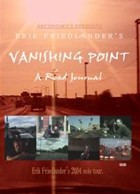Home » Jazz Articles » Film Review » Erik Friedlander's Vanishing Point: A Road Journal
Erik Friedlander's Vanishing Point: A Road Journal
 Erik Friedlander
Erik FriedlanderVanishing Point
Arconomics ARC01
2005
One man and a cello. It's hard to imagine that the instrument could occupy a solo space for the duration of an entire album, let alone a concert performance. But when the cellist is Erik Friedlander, a remarkable player who has worked with artists as broad-reaching as John Zorn, Joe Lovano, Fred Hersch and Marty Ehrlich, not to mention his own body of recordings including three with his genre-bending group Topaz, nothing should come as a surprise. Few cellists today demonstrate the combination of extended technique, quick intuition and the ability to find music in the most pedestrian or exotic of surroundings as Friedlander. And with experiences in both improvised and structured music, and often occupying the space between, Friedlander has always been a player to challenge the boundaries of his instrument.
And so, on the heels of his 2003 release Maldoror — a series of daring improvisations inspired by pieces of poetry shown to him immediately before each piece — Friedlander took to the road in 2004 on a North American solo tour that saw him perform 18 concerts in just 22 days, from Montreal, Canada to Los Angeles, California. Armed with a video camera, Friedlander and road companions Kurt Gellerstad and Lee Friedlander filmed the experience of a low-maintenance tour, the result being Vanishing Point: A Road Journal, a combination road diary/concert film that provides an intriguing look at life on the road.
With almost no dialogue, Friedlander's cello provides the sonic backdrop for the 50 minute film, with improvised pieces seeming to mesh seamlessly with travel footage, and managing to convey the tedium of long highway trips and the busier activity of urban surroundings.
But the real meat of the film is the concert footage, filmed at commercial venues, radio stations and even at a house concert — an increasingly-successful concept where performers literally play in a home, and a hat is passed around to pay the artist. Listening to Friedlander perform, one often wonders how he manages to pull so much sound out of a single instrument, but the opportunity to actually watch him in performance reveals the breadth of his technique. Sometimes bowing the cello, sometimes scraping it, other times strumming it like a guitar, it's even more creative techniques — such as a piece where Friedlander bows a long note on one string, and with his left hand simultaneously holds down a note on another string with one finger and plucks it with a different one '" where one finally understands how he is able to make one instrument sound like many.
While the video quality ranges from low-tech to high, the audio, with the exception of one piece clearly recorded with a room mic, is full and crystal clear. There are no bonus features, but the short film's vivid sense of light and dark, gentility and aggression, loneliness and camaraderie makes for an engaging watch. And, concert footage aside, the music is so well-integrated with the road images that the film takes on a greater purpose.
It's more than a concert film scattered with images of life on the road; it's a truly seamless blend of sound and image that gives Vanishing Point: A Road Journal a sense of elevated art.
Visit Erik Friedlander on the web.
Personnel: Erik Friedlander (cello)
Chapter Listing: Titles; Crawl; May it Please; On the Road: L.A.; Amber; Buds; On the Road: Oregon; The Wind Groans; Tough Guy; On the Road: Buffalo; Here Comes the Madwoman; On the Road: To Chicago; I Am Filthy; On the Road: Michigan; Radio; Pig's Feet; On the Road: Oakland; Kick the Can
NOTE: Vanishing Point is a two-sided disc, with one side in NTSC format, the other PAL.
< Previous
May 2005
Next >
Knowing You
Comments
Tags
For the Love of Jazz
 All About Jazz has been a pillar of jazz since 1995, championing it as an art form and, more importantly, supporting the musicians who create it. Our enduring commitment has made "AAJ" one of the most culturally important websites of its kind, read by hundreds of thousands of fans, musicians and industry figures every month.
All About Jazz has been a pillar of jazz since 1995, championing it as an art form and, more importantly, supporting the musicians who create it. Our enduring commitment has made "AAJ" one of the most culturally important websites of its kind, read by hundreds of thousands of fans, musicians and industry figures every month.























